- Learning time
- 60 minutes
- First play time
- 120 minutes
Ahoy
Designed by: Greg Loring-Albright
Ahoy is a strange brew, of asymmetric factions playing a game of dominance on the high seas (the Bluefin and Mollusc players) or smuggling under their noses, and betting on the outcomes of the aforementioned battle (the Smugglers, of which there can be one or two).
At the start of the game just two sea tiles represent the playing area. Each sea tile is divided into four spaces, one of which has an island. The Bluefin and Mollusc players place their flagships on these two initial islands, with the Smuggler players beginning with their boats at sea.
Ahoy takes place over a number of rounds, at the start of which everyone rolls their dice before choosing, in turn, how to spend them. On your turn you’ll take two or more actions, and the available actions are shown on your own faction board. Some actions are ‘free’ – in that they don’t cost any dice – so if you’re at an island, you can pay gold to recruit crew members (represented by cards) to your cause; or as a smuggler, you can freely gather cards for their secondary use: smuggling. Critical to note here, however, is that cards come in different suits, and you can only recruit/smuggle cards from an island with a matching suit. This geographical handicap gives the smugglers in particular something to consider during the game, as smuggled goods demand particular destinations: ideally, you don’t want to waste lots of actions on moving about and delivering a single good, when you could be sailing a short distance to deliver two instead. When smugglers deliver, they score points and gain rewards, but they also get to pledge their delivered goods: effectively, a pledge is a wager on which of the more belligerent factions will control the island in question at the end of the game: the Bluefin or Molluscs. And that fight is playing out in a rather different style…
The Bluefin and Mollusc don’t smuggle or deliver, but instead battle for supremacy of the seas. Each tile in Ahoy’s growing play area has a point value, tracked by blue dice – they all begin at 1pt but increase with any smuggler delivery to the island there. If you’re playing one of these factions, you score points for every tile you control – ie, have the most presence on that tile – at the end of every round. Both the Bluefin and Mollusc players have a variety of ships, patrols, strongholds etc they can establish on the tiles.
But we were talking about actions, and most actions cost dice: everybody can sail, which allows them to move around the board. This may lead to exploring (adding more sea tiles) or battle, where players fight each other. Fighting is a simple die-roll for each player, with the higher roll winning, but you can improve your chances by loading cannons on your ship: again; this costs dice, but essentially reducing the pip value of your cannon die pushes up your combat roll.
The other thing that might help you in combat (amongst other things) are the crew cards you recruit from the islands. Crew are available to everyone, but usually cost gold to hire, which forms the game’s central currency; you can also use gold to change the pip value on any die you’ve rolled. The game continues until any one faction scores 30 points or more, at which point the current round is played to it’s conclusion, and the smugglers score their pledges: the player with the most points wins!
The guru's verdict
-
Take That!
Take That!
Enough to be wary of cannons, dice rolls and ship damage. You've never sunk, but damage blocks some die slots on your ship and prevents actions.
-
Fidget Factor!
Fidget Factor!
Ahoy is not the most-immediately-accessible game we've ever encountered, in the main because of the asymmetry of the various factions. But you'll also be considering what's happening around you on the board/tiles, so it's more reactive and tactical than strategic, meaning players should be philosophical about occasional, scrutinising pauses.
-
Brain Burn!
Brain Burn!
Once you're up to speed on what each faction is capable of, it's not too onerous at all. The burniness is more to do with how everyone is interacting (see fidget factor)
-
Again Again!
Again Again!
Lots of in-built variety in the layout of tiles, distribution of cards and ramifications thereof for the players.

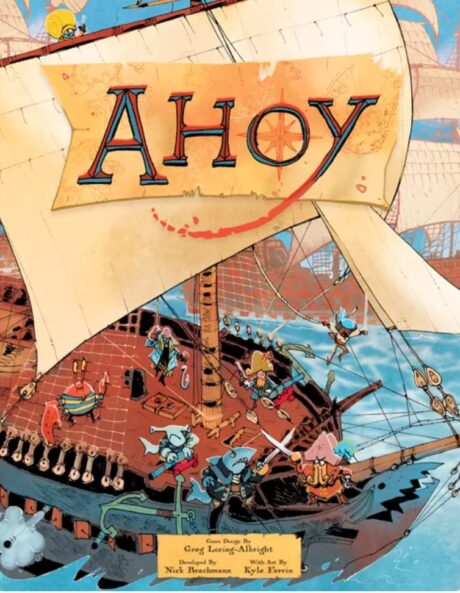
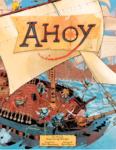
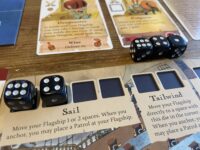
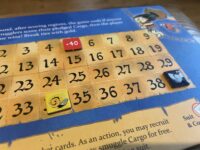
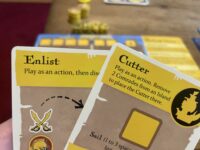
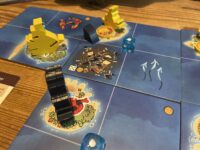
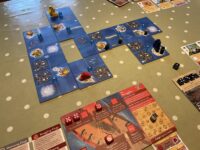



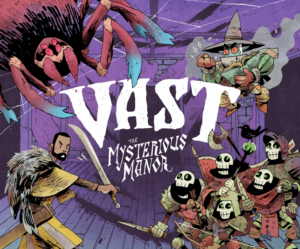
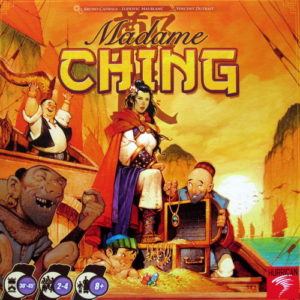
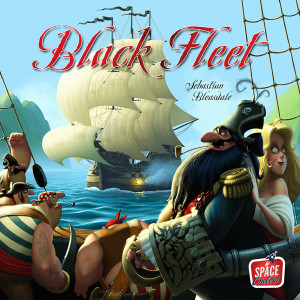
Sam says
Ahoy sits omewhere between the simple pirate game of Black Fleet and the complex, asymmetric war game Root. In the latter, every player operates in very different ways and the only shared rules are about board movement and combat. In the former, you sail around raiding with one ship (pirates) whilst blowing others up with another (Navy). Ahoy's appeal lies in combining the avast-me-hearties Hollywoodisms of Black Fleet with a kind of Root-like (and Root-lite) asymmetry, where you can operate from a position of strength (Bluefin and Mollusc, who have some notable differences to start with) or play the very-different challenge of a smuggler, who probably wants to avoid combat entirely if they can, and sneak around like a kind of Darwinian survivalist, feeding off the dead, if that's not putting it too grimly. It's a bit of a tricky thing to teach, and I'm not sure it's a roaring success for me or the people I play with, but I appreciate what it does nonetheless: a quirky, roll-with-the-punches mash-up of two different game styles, overlapping in the same space. Lovingly produced, it also doesn't outstay it's welcome, normally wrapping up in about an hour (be prepared for longer for your first game!)